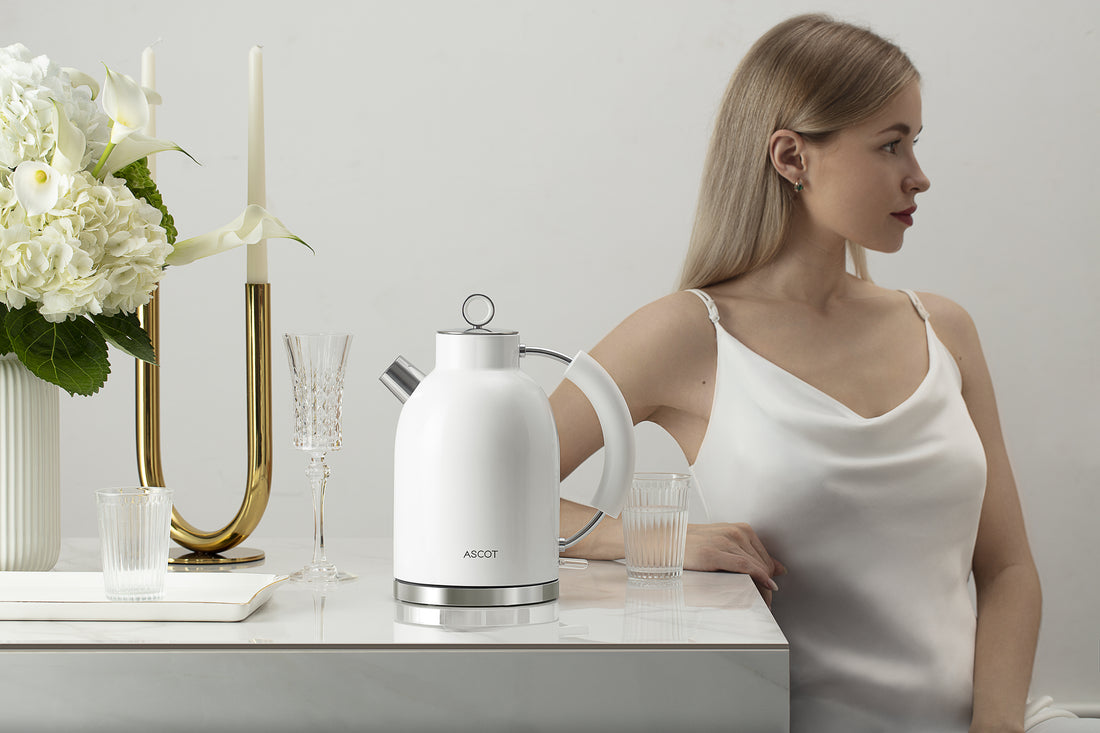Introduction
Electric kettles, seemingly simple household devices, are underpinned by a rich tapestry of design, history, and technological evolution. Their modern versions represent a fascinating confluence of innovation, stretching far back into the annals of time. Yet, even as we revere the old, there's an unmistakable nod to the new—a recognition of today's growing emphasis on sustainability.
Today, as eco-consciousness takes center stage, the kettle's journey is worth understanding more than ever. Not just as a nod to our evolving technological prowess, but also as an emblem of how far we've come in aligning our daily habits with sustainable choices. In the same vein, choices like investing in an eco-friendly 8-person tent for our outdoor adventures underscore our commitment to marrying function with eco-responsibility. Whether it's sipping a cup of tea brewed to perfection or sleeping under the stars, the tools we choose say a lot about the world we want to create.
History of the Kettle
The humble kettle, often an unsung hero in our kitchens, has a history as rich and diverse as the cultures it has touched. To truly appreciate its design and significance, one must venture back to its earliest days, drawing parallels with its contemporary electric counterparts.
The Dawn of Kettle Designs
The kettle's inception can be traced back to ancient civilizations, where rudimentary pots made from clay or metal served the primary purpose of boiling water over open flames. These early designs were simple but served the essential function of heating water, paving the way for the more advanced models we're familiar with today.
The Water Kettle's Global Influence
As societies evolved, so did the kettle. The advent of the water kettle heralded a new era of communal bonding and global cultural exchanges. From the traditional Japanese tea ceremonies to the British afternoon tea rituals, the water kettle became an integral part of many cherished traditions. It not only facilitated the brewing of beverages but also became a symbol of hospitality, shared moments, and cultural convergence.
Electrifying the Kettle: A Modern Revolution
The true metamorphosis of the kettle, however, came with the introduction of electricity. The late 19th and early 20th centuries witnessed the birth of the electric kettle, revolutionizing the way we approached the simple act of boiling water. This innovation stemmed from a desire for convenience, efficiency, and safety. No longer did one need to rely on stovetops or open flames; with a simple flick of a switch, water could be heated in minutes. This not only changed household dynamics but also set the stage for the myriad of advanced features and designs we associate with modern electric kettles.
Design and Evolution
The electric kettle, a symbol of modern convenience, didn't just materialize out of thin air. It is the result of innovative thinking, years of experimentation, and a response to societal needs. Delving into its history helps us appreciate not only its functional attributes but also the visionary minds and circumstances that shaped its existence.
The Visionaries Behind the Electric Kettle
Although the evolution of the electric kettle was a cumulative effort of several inventors and engineers, the first patents for this appliance can be attributed to the British. John C. Taylor, for instance, played a pivotal role in designing the modern thermostatic kettle. Such inventors were driven by a passion for innovation, looking to merge the age-old process of boiling water with the newfound wonders of electricity.
The Pioneering Nation: Britain's Key Role
Britain undeniably took the lead when it came to the invention and popularization of electric kettles. By the early 20th century, the UK was already buzzing with electrical innovations, and the kettle was no exception. British homes, renowned for their love of tea, became the perfect testing grounds for these new devices, leading to rapid advancements and widespread adoption.
Invention Born from Necessity and Desire
So, what fueled this transition from traditional to electric kettles? The answer lies in a blend of necessity and desire. As urban lifestyles became busier, there was a pressing need for quicker, more efficient ways to boil water. Furthermore, the electric kettle's inception was driven by safety concerns, reducing the risks associated with open flames and boiling water on stovetops. Ultimately, it was about bringing convenience, speed, and safety to every kitchen, ensuring that a comforting cup of tea was never more than a few minutes away.
Functional Aspects of the Electric Kettle
Electric kettles have transcended their basic role of simply boiling water. Modern designs are packed with features that cater to diverse needs, ensuring users get the best out of their appliance. As we explore the functional aspects of the electric kettle, it becomes evident how this household item has turned into a marvel of engineering and utility.
Diverse Functions: More Than Just Boiling
At a glance, an electric kettle's primary function is to heat water rapidly. However, today's versions offer much more:
- Temperature Settings: Catering to different beverages like green tea, black tea, and coffee, some kettles allow users to select precise temperatures, ensuring optimal brewing.
- Keep Warm Feature: This function maintains the water at a desired temperature for extended periods, making it ideal for prolonged use or larger gatherings.
- Auto Shut-off: An essential safety feature, kettles automatically switch off once the water reaches boiling point or if the kettle is empty.
- Boil-Dry Protection: To prevent damage, modern kettles detect when they're empty and shut off to avoid overheating.
The core of the electric kettle's functionality lies in its ability to transform electrical energy into heat. Here's a simplified explanation:
- An electric current passes through the kettle's heating element (usually made of a resistive material).
- Due to the resistance, the electric energy converts into heat energy.
- This heat is then directly transferred to the water, raising its temperature.
- As the water reaches its boiling point, steam is produced, activating the kettle's thermostat, which then triggers the auto shut-off feature.
In essence, the electric kettle is a testament to effective energy transformation, ensuring rapid heating with minimal energy wastage. This efficiency is a cornerstone of its widespread popularity and indispensable status in modern kitchens.
Materials and Construction
The electric kettle's efficiency isn't solely credited to its electronic prowess but is also deeply rooted in the materials that shape its form. Understanding the construction of electric kettles and the materials employed gives us insights into their durability, efficiency, and aesthetic appeal.
Principal Elements in Kettle Craftsmanship
Electric kettles, while varied in design, predominantly employ a select range of materials to ensure effective functioning:
- Stainless Steel: Preferred for its durability, resistance to corrosion, and efficient heat conduction, stainless steel remains a popular choice for many modern electric kettles.
- Plastic: While plastic variants are lightweight and often more affordable, it's vital to ensure they are BPA-free to prevent potential health hazards.
- Glass: Offering an elegant aesthetic, glass kettles allow users to visually track the boiling process. They are often made from borosilicate glass, known for its resistance to thermal shocks.
- Copper: While less common in contemporary designs, copper kettles boast excellent heat conductivity and a unique vintage aesthetic.
Evolutions Stemming from Material Innovations
The advancements in material science have continually shaped the trajectory of kettle designs:
- Heat-resistant Handles: The development of heat-resistant polymers has enabled the creation of kettle handles that remain cool to touch, enhancing user safety.
- Improved Insulation: Modern materials offer better insulation, ensuring that kettles retain heat longer, making them energy-efficient.
- Eco-friendly Materials: With growing environmental concerns, there's a push towards using recyclable and sustainable materials in kettle construction.
In wrapping up, it's clear that the convergence of material science and design innovation has been pivotal in elevating the humble kettle into a household essential. From the earliest clay pots to the sophisticated electric kettles we know today, each material choice and design shift reflects humanity's enduring quest for efficiency, safety, and aesthetics.
Modern Day Kettle Technology
The electric kettle of today stands as a testament to human ingenuity, with designs that prioritize functionality, energy efficiency, and aesthetics. This evolution is backed by technological advancements that have redefined what we expect from a simple appliance meant for boiling water.
State-of-the-art Features Elevating User Experience
- Rapid Boil Technology: A feature highly sought-after in contemporary kettles, rapid boil technology ensures that users get hot water in a fraction of the time, saving both energy and time.
- Precision Temperature Control: Catering to the connoisseurs of beverages, many kettles now offer granular temperature settings, allowing for optimal brewing conditions, whether it's for a delicate green tea or a robust coffee.
- Smart Kettle Innovations: Syncing with the era of smart homes, some electric kettles can now be controlled via smartphone apps or voice assistants, offering users the convenience of remote operations, boil notifications, and more.
Eco-conscious Designs and Implications
- Energy Efficiency: Modern electric kettles often come with energy-saving features, ensuring minimal wastage. This not only reduces electricity bills but also aligns with global efforts to reduce carbon footprints.
- Eco-friendly Components: As sustainability becomes a universal priority, we are witnessing a surge in kettles constructed with recyclable materials, emphasizing a more eco-conscious product lifecycle.
Today's kettles are not just functional tools; they are also kitchen showpieces. The emphasis on:
- Stylish Designs: Sleek finishes, modern touches, and elegant patterns are now commonplace, ensuring that the kettle complements the aesthetics of contemporary kitchens.
- Ergonomic Constructs: The design considerations now also prioritize user comfort, with kettles featuring easy-grip handles, non-drip spouts, and compact bases for easy rotation and handling.
In conclusion, the modern electric kettle is a convergence of advanced technology, sustainable practices, and thoughtful design. It encapsulates how we, as a society, continue to innovate and refine everyday objects to better serve our evolving needs, all while making responsible choices for our planet.
Conclusion: The Evolutionary Tale of Electric Kettles
As we've journeyed through the annals of time, the electric kettle emerges as more than just a household appliance. It is a testament to human ingenuity, capturing the essence of evolving lifestyles, design preferences, and breakthroughs in technology.
The history of the electric kettle traces back to a blend of need and innovation. From traditional water vessels to the modern energy-efficient designs, each phase marks a pivotal moment in human advancement.
The electric kettle's design evolution is a vivid reflection of our constant pursuit of balancing aesthetics with practicality. Modern designs are no longer just about boiling water; they represent style, ease of use, and technological prowess.
As for technological advancements, from the innovative rapid boil technology to smart kettles that can be controlled with a smartphone, the electric kettle continues to adapt and cater to our ever-evolving needs.
In essence, the electric kettle's journey is a mirror to our own – constantly growing, adapting, and looking forward to the next big innovation.

